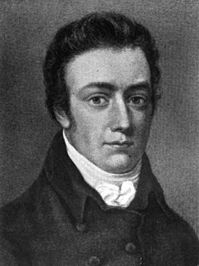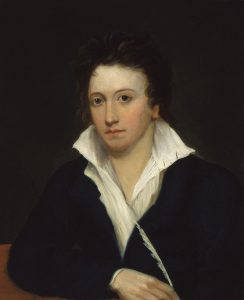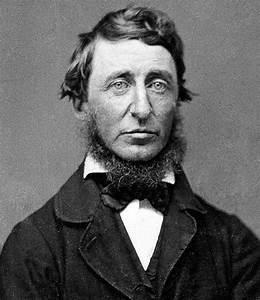8 Chapter 8: Romanticism
Learning Objectives ~ Chapter 8 “Romanticism”
- Define Romanticism and describe the Romantic perspective
- Explore the human experience through the lens of the Romantic perspective
- Discuss the works of major Romantic poets and artists
- Consider the Romantics perspective on human nature and on nature and the environment
This brief interview, from PBS News Hour, provides a starting point for Romanticism:
Why should every student in America read Henry David Thoreau’s Walden? Essentially, because Thoreau’s life, experience, will and notions of individual freedom and the responsibility that come with that freedom continue to be relevant in our contemporary social and political conversations. Thoreau was a Romantic, an American Romantic. But what does that mean? In this chapter we look at the Romanticism movement in Europe and North America.
The Romanticism Movement ~ The Ideal Vehicle of Poetry
Romanticism was an artistic, literary, musical and intellectual movement that originated in Europe toward the end of the 18th century, and in most areas was at its peak in the approximate period from 1800 to 1850. Romanticism was characterized by its emphasis on emotion and individualism as well as glorification of all the past and nature, preferring the medieval rather than the classical. It was partly a reaction to the Industrial Revolution, the aristocratic social and political norms of the Age of Enlightenment, and the scientific rationalization of nature—all components of modernity. It was embodied most strongly in the visual arts, music, and literature, but had a major impact on historiography, education, and the social sciences. It had a significant and complex effect on politics, with romantic thinkers influencing liberalism, radicalism, conservatism and nationalism.
The movement emphasized intense emotion as an authentic source of aesthetic experience, placing new emphasis on such emotions as apprehension, horror and terror, and awe—especially that experienced in confronting the new aesthetic categories of the sublimity and beauty of nature. It elevated folk art and ancient custom to something noble, but also spontaneity as a desirable characteristic (as in the musical impromptu). In contrast to the Rationalism and Classicism of the Enlightenment, Romanticism revived medievalism, and elements of art and narrative perceived as authentically medieval in an attempt to escape population growth, early urban sprawl, and industrialism.
Although the movement was rooted in the German Sturm und Drang movement, which preferred intuition and emotion to the rationalism of the Enlightenment, the events and ideologies of the French Revolution were also proximate factors. Romanticism assigned a high value to the achievements of “heroic” individualists and artists, whose examples, it maintained, would raise the quality of society. It also promoted the individual imagination as a critical authority allowed of freedom from classical notions of form in art.
Here is a Beginner’s Guide to Romanticism via SmartHistory:
With these basic tenets in mind, we turn to the English Nature Poets.
The Romantic Perspective: Poetry Gives Access to Self, Feeling, and Nature

William Wordsworth (7 April 1770 – 23 April 1850) was an English Romantic poet who, with Samuel Taylor Coleridge, helped to launch the Romantic Age in English Literature with their joint publication Lyrical Ballads (1798). Wordsworth’s magnum opus is generally considered to be The Prelude, a semi-autobiographical poem of his early years that he revised and expanded a number of times. It was posthumously titled and published by his wife in the year of his death, before which it was generally known as “the poem to Coleridge”. Wordsworth was Britain’s poet laureate from 1843 until his death from pleurisy on 23 April 1850.
The second of five children born to John Wordsworth and Ann Cookson, William Wordsworth was born on 7 April 1770 in what is now named Wordsworth House in Cumberland, part of the scenic region in northwestern England known as the Lake District. The beauty of the Lake District made an immeasurable impact on his sensibility. It was a place of quiet and beauty, a sacred space, which is a theme that interlaces through much of his work. William’s sister, the poet and diarist Dorothy Wordsworth, to whom he was close all his life, was born the following year, and the two were baptized together. They had three other siblings: Richard, the eldest, who became a lawyer; John, born after Dorothy, who went to sea and died in 1805 when the ship of which he was captain, the Earl of Avergavenny, was wrecked off the south coast of England; and Christopher, the youngest, who entered the Church and rose to be Master of Trinity College, Cambridge.
Wordsworth’s father was a legal representative of James Lowther, 1st Earl of Lonsdale and, through his connections, lived in a large mansion in the small town. He was frequently away from home on business, so the young William and his siblings had little involvement with him and remained distant from him until his death in 1783. However, he did encourage William in his reading, and in particular set him to commit large portions of verse to memory, including works by Milton, Shakespeare and Spenser. William was also allowed to use his father’s library. William also spent time at his mother’s parents’ house in Penrith, Cumberland, where he was exposed to the moors, but did not get along with his grandparents or his uncle, who also lived there. His hostile interactions with them distressed him to the point of contemplating suicide. More on Wordsworth’s life and career can be found here.
Please read [I wandered lonely as a cloud]
In this poem, Wordsworth tells of his experience wandering the fields by the lake. He is lonely, the solitary poet, seeking inspiration. In the natural beauty, though, he realizes that he is not alone. He is not this disconnected vapor, like a cloud. He is actually in good company. A field of daffodils, dancing with but outshining the grass, is his company. They and the moment are his inspiration. The poet’s inspiration is found in the smallest things. He also realizes that the memory of that moment is his forever.
Please read “The World is Too Much With Us”
This is a sonnet, a 14 line poem that poses a problem or question and the beginning and then works through it. The last two lines provide the new insight gotten through this method of inquiry. In this poem, Wordsworth declares that the world, or think of it as “worldly cares,” are a detrimental preoccupation for us. The tyranny of the clock and time, getting things, spending money, trying to keep up, these things wear us out. In all our possessions we really do not have anything truly worthwhile if we have given up our souls. He longs for a previous type of existence, perhaps even pagan times when the imagination was free.
Please read “Mutability”
As the title suggests, this poem is about change, the nature of change, its inevitability, and how we should never fear what is natural. The word ‘dissolution’ can be understood in terms of the conclusion of life and one is also invited to understand it in terms of a rise and fall of decadence, a tearing down of one’s potential because of intemperance. Wordsworth is being rather philosophical when he claims that Truth is a constant, but our images of it are hindered by our own lack of faith, imagination and inability to keep our appetites in check.
You are invited to peruse more of Wordsworth’s poems here, via the poetryfoundation.org site: William Wordsworth
***************************************************************************************************************************************

Samuel Taylor Coleridge (21 October 1772 – 25 July 1834) was an English poet, literary critic, philosopher and theologian who, with his friend William Wordsworth, was a founder of the Romantic Movement in England and a member of the Lake Poets. He also shared volumes and collaborated with Charles Lamb, Robert Southey, and Charles Lloyd. He wrote the poems The Rime of the Ancient Mariner and Kubla Khan, as well as the major prose work Biographia Literaria. His critical work, especially on William Shakespeare, was highly influential, and he helped introduce German idealist philosophy to English-speaking culture. Coleridge coined many familiar words and phrases, including suspension of disbelief. He had a major influence on Ralph Waldo Emerson and on American transcendentalism.
Throughout his adult life Coleridge had crippling bouts of anxiety and depression; it has been speculated that he had bipolar disorder, which had not been defined during his lifetime. He was physically unhealthy, which may have stemmed from a bout of rheumatic fever and other childhood illnesses. He was treated for these conditions with laudanum, which fostered a lifelong opium addiction. For more on his life and career, see here.
Coleridge’s poems often have a broody tone and are often rather fantastical. In true Romantic fashion, he longed for states of mind that were beyond his reach and he looked to dreams and narcotics to help him on this quest. Some of his most intriguing poems are the result of opium-induced dreams.
Please read “Kubla Khan”
Here are some ways (analysis) to think about this poem. Coleridge composed his poem, Kubla Khan is a state of semi-conscious trance either in the autumn of 1797 or spring of 1798 and published in 1816. The whole poem is pervaded by an atmosphere of dream and remains in the form of a vision. The vision embodied in Kubla Khan was inspired by the perusal of the travel book, Purchas His Pilgrimage. Coleridge had taken a doze of opium as an anodyne, and his eyes closed upon the line in the book, “At Zanadu Kubla Khan built a pleasure palace.” But this opened his creative vision, and the poem of about 200 lines was composed in this state of waking dream. On being fully awake, he wrote the poem down. The theme of the poem is unimportant. It describes the palace built by Kubla Khan, the grandson of Ghengis Khan, the great rule of central Asia.
This poem is the finest example of pure poetry removed from any intellectual content. Being essentially of the nature of a dream, it enchants by the loveliness of its color, artistic beauty, and sweet harmony. Its vision is wrought out of the most various sources –oriented romance and travel books. Its remote setting and its delicate imaginative realism renders it especially romantic. The supernatural atmosphere is evoked chiefly through suggestion and association. The musical effect of the poem is unsurpassed. The main appeal of the poem lies in its sound effects. The rhythm and even the length of the lines are varied to produce subtle effects of harmony. The whole poem is bound together by a network of alliteration, the use of liquid consonants, and onomatopoeia. The judicious use of hard consonants has given occasionally the effect of force and harshness.
“Kubla Khan” invites us into ‘suspension of disbelief,’ into the world of dreams and imagination. Which, to Coleridge and other Romantics, is a place of rich wonders and it behooves us all to be fearless enough to be willing to look.
Please read “Cristabel”
This rather gothic poem is fascinating and much critical work has been done on it. Since it is such a lengthy poem, you may find it easier to read an analysis in tandem with reading the poem: analysis of Cristabel
********************************************************************************************************

Percy Bysshe Shelley (4 August 1792 – 8 July 1822) was one of the major English Romantic poets, who is regarded by some as among the finest lyric and philosophical poets in the English language, and one of the most influential. A radical in his poetry as well as in his political and social views, Shelley did not see fame during his lifetime, but recognition of his achievements in poetry grew steadily following his death. Shelley was a key member of a close circle of visionary poets and writers that included Lord Byron, John Keats, Leigh Hunt, Thomas Love Peacock and his own second wife, Mary Shelley, the author of Frankenstein.
Shelley’s close circle of friends included some of the most important progressive thinkers of the day, including his father-in-law, the philosopher William Godwin, and Leigh Hunt. Though Shelley’s poetry and prose output remained steady throughout his life, most publishers and journals declined to publish his work for fear of being arrested for either blasphemy or sedition. Shelley’s poetry sometimes had only an underground readership during his day, but his poetic achievements are widely recognized today, and his political and social thought had an impact on the Chartist and other movements in England, and reach down to the present day. Shelley’s theories of economics and morality, for example, had a profound influence on Karl Marx; his early – perhaps first – writings on nonviolent resistance influenced Leo Tolstoy, whose writings on the subject in turn influenced Mahatma Gandhi, and through him Martin Luther King Jr. and others practicing nonviolence during the American civil rights movement.
******************************************************************************************************
American Romanticism
The ideas of the Romanticism movement in Europe made their way across the Atlantic. And it makes sense! After all, in the imagination of many, North America was still an Eden, a paradise, an unspoiled land that could provide a spiritual grounding in a world that was speeding toward modernity. Please read these essays on Romanticism in the United States. These essays are short and lively, and they provide background on artists, like Thomas Cole and Alfred Bierstadt, who captured so perfectly the unspoiled American landscape. There are also some videos!
https://smarthistory.org/americas-before-1900/united-states-19th-century/romanticism-in-the-united-states/
*********************************************************************************************
American Literature

This chapter initiated with a brief conversation about the importance of reading the work of Henry David Thoreau. Just having a sense of who this man was, what he wrote, and the principles that he lived by, is an exercise in the Romantic sensibility. Remember that the Romantic perspective is one that embraces individuality, independence, self reliance. The Romantic finds the sacred not in church services, but in a hike in the woods. The Romantic seeks to set clear ethical and moral principles and then live by them.
Here is an online edition of Thoreau’s Walden. I invite you to read the introduction and then the first two chapters. In chapter 1, he tells the reader his motivation for moving to the woods. He expresses ideas gleaned from his studies in addition to what he has observed of “modern life” that is ironically, brutish. In chapter 2, he recounts his daily routine and his principles of living with economy. He writes:
“I went to the woods because I wished to live deliberately, to front only the essential facts of life, and see if I could not learn what it had to teach, and not, when I came to die, discover that I had not lived. I did not wish to live what was not life, living is so dear; nor did I wish to practice resignation, unless it was quite necessary. I wanted to live deep and suck out all the marrow of life, to live so sturdily and Spartan-like as to put to rout all that was not life, to cut a broad swath and shave close, to drive life into a corner, and reduce it to its lowest terms, and, if it proved to be mean, why then to get the whole and genuine meanness of it, and publish its meanness to the world; or if it were sublime, to know it by experience, and be able to give a true account of it in my next excursion.”
On the Duty of Civil Disobedience
********************************************************************************************
Romanticism in Music
The height of Romanticism in music. Beethoven’s Ode to Joy!

